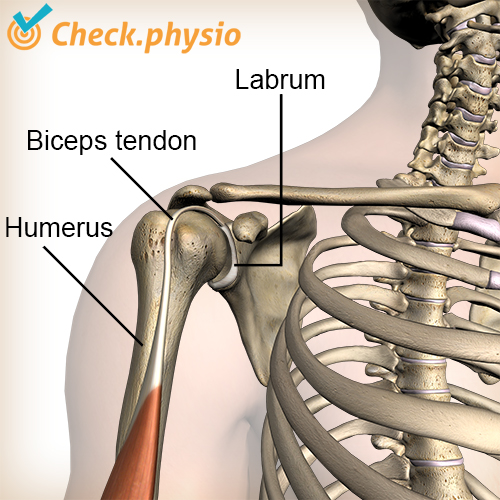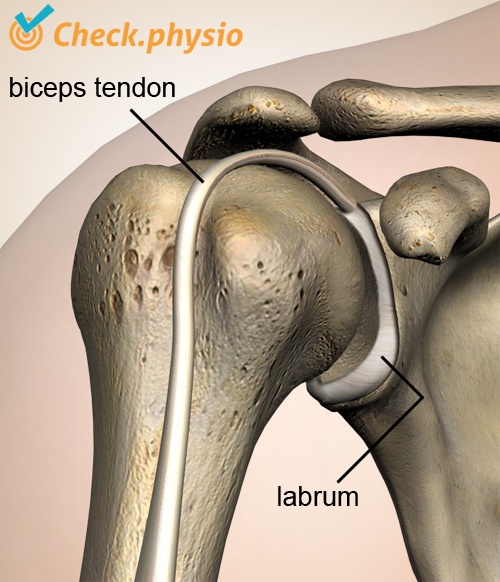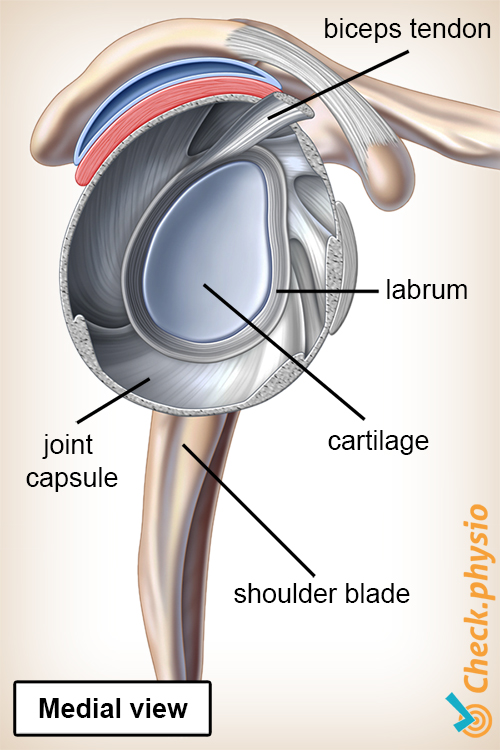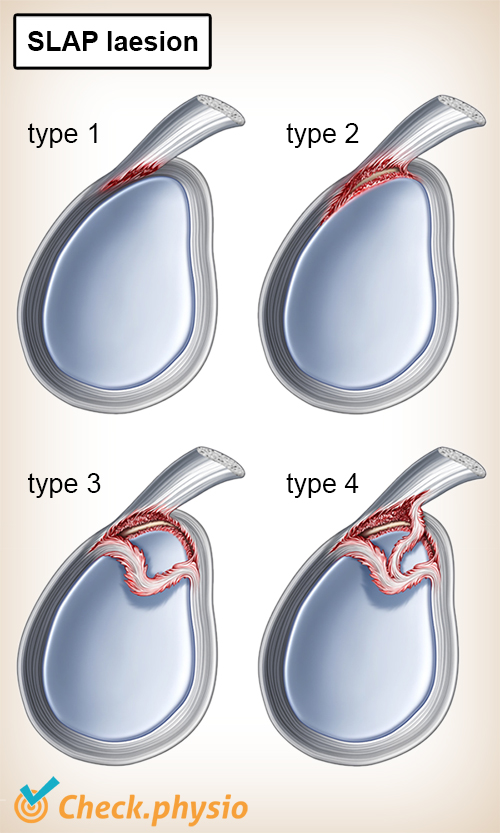- Conditions
- SLAP lesion
SLAP lesion Superior labral anterior to posterior lesion / labral tear
Introduction
The labrum is a ring of connective tissue in the shoulder. The tendon of the biceps muscle attaches to this ring. In case of a SLAP lesion, the part of the labrum that the biceps tendon attaches to has been torn.
SLAP lesions often occur in overhead athletes due to frequent overhead movement of the arm. In addition, a SLAP lesion can also develop acutely after, for example, falling on an outstretched arm.

Description of condition
The shoulder consists of the shoulder blade (scapula), the upper arm (humerus) and the collarbone (clavicle). The glenoid fossa or socket is part of the shoulder blade. Because the glenoid fossa is very small and shallow in proportion to the humeral head, the labrum is found around the edge of the fossa. This extra edge makes the fossa 50% deeper, so that the humeral head fits better in the socket. This gives the shoulder joint more stability.
Various ligaments and muscles attach to the labrum. The most important one is the biceps tendon, which is attached to the top of the labrum. In a SLAP lesion, the part of the labrum that the biceps tendon attaches to is torn. This is often the result of the large tensile forces that the biceps muscle can exert on the labrum. If the tear increases in size, a flap may even develop, in which case the labrum is completely detached from the glenoid cavity.
Types
There are different types of SLAP lesions:
Type 1
Degenerative defects (as a result of tissue deterioration) cause some tears in the labrum. In this type, the labrum is still attached to the glenoid fossa.
Type 2
In type 2, there is a longitudinal tear in the labrum meaning the biceps tendon is detached from the glenoid fossa. This can cause a feeling of instability.
Type 3
In this type, a so-called "bucket handle" tear is present. This means that the longitudinal tear is a flap tear. This flap can move and get stuck inside the joint.
Type 4
The bucket handle tear is larger and runs through the biceps tendon. The biceps tendon is also split in this case.
Cause and history
Tears in the labrum can also develop as a result of degenerative conditions. This includes, for example, the normal aging process that can cause damage to the tissue. In overhead sports, such as tennis, volleyball and throwing in baseball, this damage may occur younger.
Because of the position of the shoulder, for instance when throwing, the labrum may also get stuck between the glenoid fossa and the humeral head. When this happens, a tear can occur in the labrum.
Because the tendon of the biceps is attached to the labrum, the labrum is also sensitive to large tensile forces. If the tendon pulls often and hard on the labrum, tears may develop. This can also happen acutely when falling onto an extended arm, or falling off something. For example, when falling down some steps if you try to hold fast to a railing above you.
Signs & symptoms
When a SLAP lesion develops acutely, a sharp pain may be felt in the shoulder, resulting in reduced mobility of the shoulder. The pain is often located deep in the shoulder.
With SLAP lesions that develop gradually, this sharp pain in the shoulder relates to a movement, but mainly one used in overhead activities. It may also feel as if something is jammed when moving the arm above shoulder height.
The most important symptoms of a SLAP lesion are:
- Sharp pain in the shoulder, mostly during overhead movements.
- Feeling as if something is stuck in the shoulder.
- Clicking / cracking / snapping sounds.
- Feeling of instability in the shoulder.
- Decreased range of motion for the shoulder.
- Loss of strength in the affected arm.
Diagnosis
It is very difficult to diagnose a SLAP lesion. However, an interview about the complaints and their onset, as well as some shoulder tests, can raise the suspicion of a SLAP lesion. An MRI is then the best way to confirm this.
Treatment and recovery
The treatment of a SLAP lesion may be conservative (without surgery) or surgical. This depends on the severity of the symptoms. A treatment plan will be drawn up in consultation with your physiotherapist/orthopedic surgeon.
The treatment focuses mainly on the instability and functional limitations that result from the symptoms. Conservative treatment is preferred where possible. In most cases, the course of treatment therefore consists of conservative treatment first. After a certain period, the effect of the treatment will be evaluated.
Initially, conservative treatment consists of correctly identifying the cause of the symptoms. This is especially important for problems that did not develop acutely. If the cause is tackled, the chance of recurrence is much lower. A physiotherapist will look closely at how the entire shoulder complex moves. Which can then be improved. In addition, exercise therapy is often applied to increase shoulder stability and to strengthen the attachment of the biceps tendon.
Surgery
A SLAP lesion type I is usually not operated on. However, if conservative treatment fails, or for types II, III and IV, the decision may be made to proceed with surgery.
Exercises
Take a look at the exercise program with exercises for a SLAP lesion.
More info
You can check your symptoms using the online physiotherapy check or make an appointment with a physiotherapy practice in your locality.
References
Magee, D.J., Zachazewski, J.E., Quillen, W.S., Manske, R.C. (2016) Pathology and intervention in musculoskeletal rehabilitation Elsevier, 2nd edition.
Wilk, K.E., Reinold, M.M. & Andrews, J.R. (2009) The atlete's shoulder Philadelphia: Churchill livingstone. Elsevier.
Cleland, J. (2007) Orthopaedic clinical examination. An evidence-based approach for physical therapists Philadelphia: Saunders. Elsevier.



